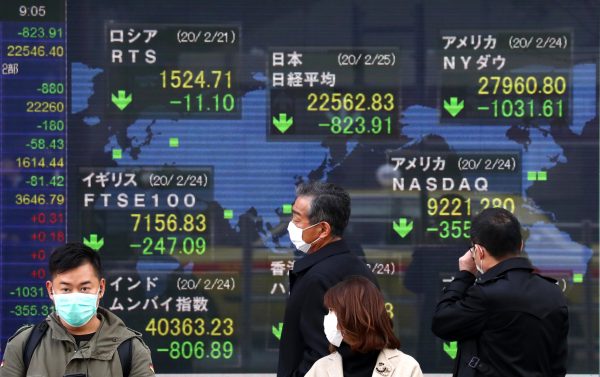The IMF projects the global economy to retreat by 3 per cent in 2020 — the sharpest contraction since the Great Depression. Year-on-year global growth is projected to decline by 6 percentage points in 2020, compared to just 3 percentage points in 2009 in the wake of the global financial crisis (GFC). While the GFC struck when economies were growing robustly, the COVID-19 crisis struck just as growth was set to decline perilously close to 2.5 per cent, the IMF’s threshold for a global recession.
Unlike the GFC, the origins of the current crisis lie outside the financial system and the real economy. What began as a health crisis was quickly transmitted to the economy through simultaneous demand and supply shocks. Incomes fell sharply as the production and the movement of goods and services came to a near standstill. Plummeting demand stressed non-financial corporations, forcing them to draw down credit limits.
This had a knock-on effect on the financial system. Banks were forced to offload treasury holdings to access cash, raising yields. This is unusual at a time when there is an increase in the demand for safe assets. Central banks quickly hit the zero lower bound and resumed quantitative easing. By 1 June, the Federal Reserve had expanded its already bloated balance sheets by over 70 per cent to 35 per cent of nominal GDP in just three months. This revived financial markets, but not the real economy.
The macroeconomic policy response of major economies mimics the GFC response, but it is more intensive despite not being coordinated through the G20.
Global trade has consequently suffered more than during the GFC, endangering the complex global supply chains that now drive most economies. The World Trade Organization estimates that merchandise trade will shrink by 13–32 per cent in 2020.
The IMF forecasts a V-shaped recovery in both advanced economies and Asia, on the lines of the Spanish Flu a century earlier. Global growth in 2021 is projected to rebound to 5.8 per cent on the best case assumption that the health emergency abates quickly.
Demand has declined on account of an enforced shutdown. This can be reversed if economies reopen quickly, as they appear to be doing. But because economies are so entwined, there remains a stagflationary risk if global trade does not bounce back. If the pandemic is protracted, a U or L-shaped recovery, or even a second Great Depression may be on the horizon.
Following the GFC, there was an inconclusive debate on how the next crisis should be handled given limited fiscal and monetary space. The recovery from the GFC was never robust enough as growth potential declined. Fiscal deficits shrank, interest rates rebounded from zero and quantitative easing ground to a halt but public debt remained at elevated levels and central bank balance sheets remained bloated.
The expected inflationary pressures failed to materialise post-GFC. Demand was constrained while an open and globalised economy cushioned supply shocks. In a financialised world, the liquidity overhang reflated asset markets rather than consumer prices. This new normal is reflected in the rise of modern monetary theory, whereby sovereign debt increases, but not tradable public debt or interest rates.
During the GFC, emerging markets and developing economies continued to grow reasonably well, albeit more slowly. But this time around, they are almost as badly affected as the advanced economies, with even the Chinese and Indian economies likely to shrink.
Asian economies have more policy space than the advanced economies. Interest rates are significantly above zero, public debt levels are half that of the advanced economies and they hold large foreign currency reserves. Asian central banks have also lowered interest rates and injected liquidity. But without aggressive fiscal support on the scale provided in advanced economies there is widespread misery, particularly in poorer South Asian countries.
Asian countries may be wary of large-scale borrowing because of shallow domestic bond markets. Fiscal deficits spilling overseas through foreign debt could expose them to external shocks such as during the Asian financial crisis. Central banks and financial systems may consequently be expected to bear a disproportionate share of the burden at a time when demand and solvency are the underlying problems, not credit or liquidity.
The roots of the current crisis do not lie in the financial system nor is this a typical recession where the cost of money set by monetary authorities is a major problem. Private and corporate income has sharply contracted. Fiscal policy needs to do the heavy lifting. The route is open also for modern monetary theory as central banks can purchase sovereign bonds beyond what their markets can absorb to contain a rise in interest rates. While this risks inflation, it is a risk worth taking.
Despite the aggressive macroeconomic policy response the nature of the global economic recovery hangs in the balance. The global economy was already in trouble when COVID-19 struck. Asian economies that had cushioned the shock during the GFC have been almost as badly hit as advanced economies, even though the health crisis was initially less severe. Advanced economies have exhausted their policy space to backstop their economies. Asian economies are yet to do so, perhaps fearing market revolt. In the event of a deepening crisis, Asian economies may have to borrow more and also make use of their large foreign currency safety nets and manage the consequences as best they can afterwards.
Alok Sheel is the Reserve Bank of India Chair Professor in Macroeconomics at the Indian Council for Research on International Economic Relations (ICRIER). He was previously Secretary in the Indian Prime Minister’s Economic Advisory Council and Additional Chief Secretary to the Kerala Government in the Indian Administrative Services.
This article is part of an EAF special feature series on the novel coronavirus crisis and its impact.

